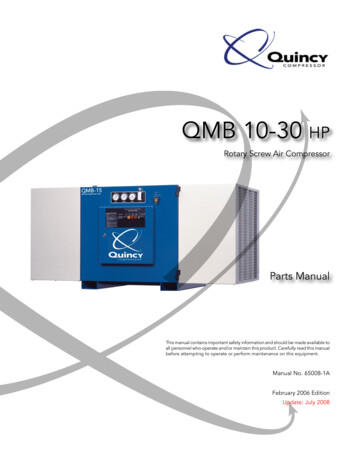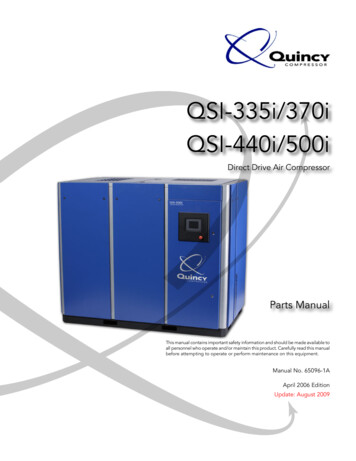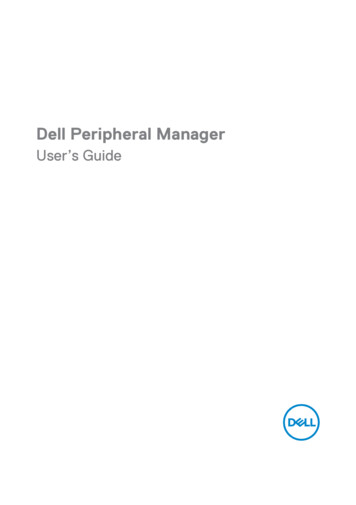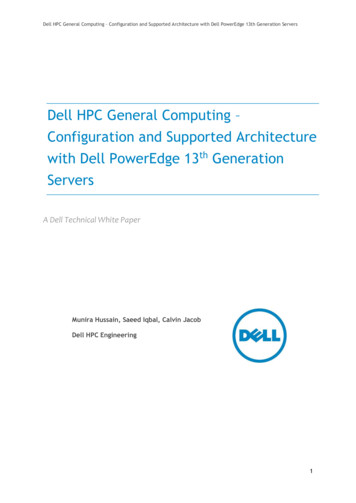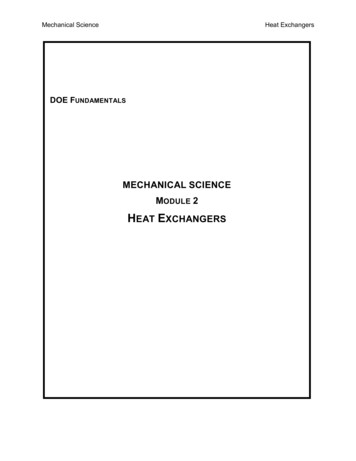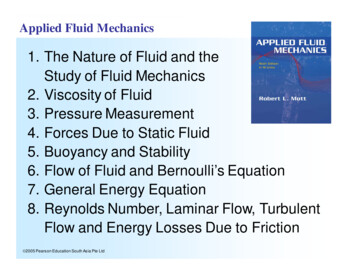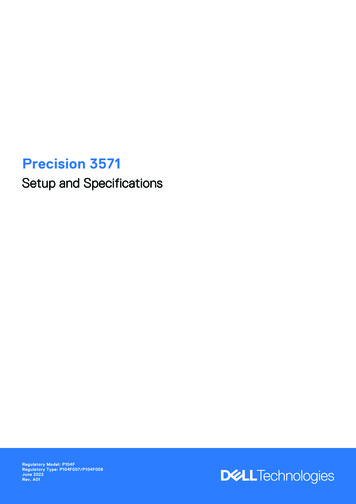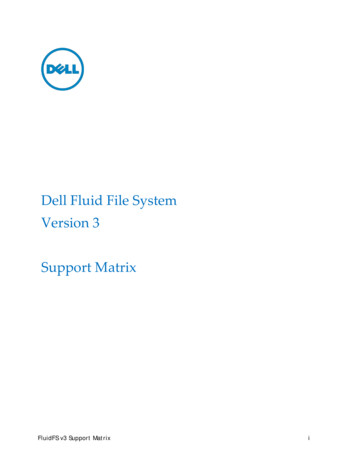
Transcription
Dell Fluid File SystemVersion 3Support MatrixFluidFS v3 Support Matrixi
Copyright 2014 Dell Inc. All rights reserved. This product is protected by U.S. and internationalcopyright and intellectual property laws. Dell and the Dell logo are trademarks of Dell Inc. in the UnitedStates and/or other jurisdictions. All other marks and names mentioned herein may be trademarks of theirrespective companies.Information in this document is subject to change without notice.Published: June 2014Part Number 680-088-002FluidFS v3 Support Matrixii
Revision HistoryDateRevisionOctober 2013AOctober 2013BNovember 2013CNovember 2013DFebruary 2014EMarch 2014FJune 2014GFluidFS v3 Support Matrixiii
Contents1 Introduction . 12 FluidFS Models and Platforms . 3Compellent Models . 3EqualLogic Models . 4PowerVault Models . 53 Software Upgrade Path . 64 FluidFS File-System Metrics . 75 Customer Environment Protocols Support . 86 SMB (CIFS) Support . 97 NFS Support . 108 User and Group Quotas . 119 FluidFS Replication . 1210 Antivirus Support . 1411 Space Pre-Allocation . 1512 Backup/Restore - NDMP . 1613 Services and Ports . 19FluidFS provided services . 19FluidFS accessed services . 2014 SNMP . 2115 Internationalization . 22NAS Access . 22Management Access . 22Potential Compatibility Issues . 22FluidFS v3 Support Matrixiv
1 IntroductionThis document provides information about supported software and hardware configurations as well asusage requirements and recommendations for Dell FluidFS v3 products.This document is valid as of FluidFS version 3.0.930714.Contacting Dell Technical Support and Customer ServiceDell support service is available to answer your questions about FS Series appliances. For FS8600 support, email the Copilot team at support@compellent.com or see the Copilot supportpage for direct phone access. Have your HSN/SSN number, case number or service tag available tovalidate support coverage. For FS7500, FS7600, or FS7610 support, visit: http://eqlsupport.dell.com For NX3500, NX3600, or NX3610 support, visit: http://support.dell.comIf you have an Express Service Code, have it ready. The code helps the Dell automated supporttelephone system direct your call more efficiently.Notes, Cautions, and Warnings A NOTE indicates important information that helps make better use of the FluidFS system. A CAUTION indicates either potential damage to hardware or loss of data and tells you how toavoid the problem. A WARNING indicates a potential for property damage, personal injury, or death.NOTE: Unless otherwise specified, all information in this document is applicable to the latest version of thefirmware and software listed below.FluidFS v3 Support Matrix1
GlossaryTable 2-1: Glossary of TermsTermFluidFS (FluidFS firmware)DefinitionA special purpose, Dell proprietary, operating system providing enterprise class NASservices using Dell PowerVault, EqualLogic, or Compellent SAN storage systemsFluidFS controllerA Dell hardware device capable of running the FluidFS firmwareNAS (FluidFS) applianceA Dell hardware product containing two FluidFS controllers in a single enclosureFluidFS system / clusterMultiple FluidFS controllers appropriately connected and configured together into asingle functional unitNAS reserve / poolThe SAN storage system LUNs (and their aggregate size) allocated and provisionedto a FluidFS systemNAS volume / containerFile system (single-rooted directory/folder and file hierarchy), defined using FluidFSmanagement functions over a portion of the NAS reserveCIFS shareA file system sub-hierarchy available to CIFS clients via the CIFS (SMB) protocolNFS exportA file system sub-hierarchy available to NFS clients via the NFS protocolFluidFS v3 Support Matrix2
2 FluidFS Models and PlatformsTables 2-1, 2-2 and 2-3 below list the platforms and configurations supported by Compellent,EqualLogic, and PowerVault systems.Compellent ModelsTable 2-1: Supported Compellent Platforms and ConfigurationsFluidFS ModelFS8600 FCFeatureClient interface and speed1GbEClient ports – per appliance8SAN storage interface and speedMinimum SAN storage firmware versionMinimum Enterprise Manager versionSAN storage modelsMaximum NAS appliancesMaximum SAN arraysMaximum NAS reserve (pool) size4FC 8GbRJ4510GbE4iSCSI 10GbE4SAN ports – per applianceEthernet Network port type10GbEFS8600 iSCSI4SFP SFP 6.3.102014 R1SC40 or SC8000422PBSupported H/W upgradesStarting from FluidFS 3.0.920760, FS8600 1GbE FC configurations can be upgraded to 10GbE FC byreplacing the Network Interface Cards. Please consult Dell Support for the implementation of thisupgrade.FluidFS v3 Support Matrix3
EqualLogic ModelsTable 2-2: Supported EqualLogic Platforms and ConfigurationsFeatureFluidFS ModelFS7500, FS7600FS7610Client interface and speed1GbE10GbEClient ports – per appliance84iSCSI 1GbEiSCSI 10GbE84SAN storage interface and speedSAN ports – per applianceInterconnect ports – per applianceEthernet Network port typeTotal SAN switch ports – per applianceMinimum SAN storage firmware versionSAN storage modelsMaximum NAS appliancesMaximum SAN arraysMaximum NAS reserve (pool) sizeFS7500 – 10 / FS7600 – N/AN/ARJ45SFP (Intel modules only) /RJ45FS7500 – 18 / FS7600 - 8417.0.0Any PS array221 group509TBNote: The Group Manager graphical interface (GUI) is based on the Java platform and can be accessedfrom any computer with a web browser and a connection to the EqualLogic SAN network. Pleaseconsult the Dell EqualLogic Group Manager Administrator's Manual for more details.Supported H/W upgradesStarting from FluidFS 3.0.920760, FS7600 (1GbE) systems can be upgraded to FS7610 (10GbE) byreplacing the Network Interface Cards. Please consult Dell Support for the implementation of thisupgrade.12All members of the EqualLogic storage group should be running firmware version 7.0 or later.FluidFS can access a single (Default) pool in an EqualLogic group. The group can contain multiple members.FluidFS v3 Support Matrix4
PowerVault ModelsTable 2-3: Supported PowerVault Platforms and ConfigurationsFeatureFluidFS ModelNX3500, NX3600NX3610Client interface and speed1GbE10GbEClient ports – per appliance84SAN storage interface and speedSAN ports – per applianceInterconnect ports – per applianceEthernet Network port typeTotal SAN switch ports – per applianceiSCSI 1GbEiSCSI 10GbE84NX3500 – 10 / NX3600 – N/AN/ARJ45RJ454NX3500 – 18 / NX3600 - 8Minimum SAN storage firmware 0iMD3600iMD3620iMD3620iMD3660iMD3660iMaximum NAS appliances12Maximum SAN arrays1SAN storage modelsMaximum number of virtual disksVirtual disk RAID levelsMaximum virtual disk sizeMaximum NAS reserve (pool) size2321/10, 5, 632TB1024TBDell PowerVault FluidFS version 3 systems can be managed from the following Web browsers: Google Chrome 31.0 or higherInternet Explorer 9 or higherMozilla Firefox 21.0 or higherFluidFS v3 Support Matrix5
3 Software Upgrade PathTable 3-1 provides the currently supported next-version upgrade paths, by current version and platform.Table 3-1 Supported Upgrade PathsCurrent Version NumberNext FluidFS Version (by /A2.0.76801.0.402N/A2.0.7680N/A1.0.407 / 10 / 76802.0.6220N/A2.0.76802.0.76802.0.6520 / 2.0.6550N/AN/A2.0.76802.0.67302.0.7680 / 3.0.920760N/A2.0.76802.0.6740N/A2.0.7680 / 0.7680N/A2.0.76802.0.71702.0.7680 / 3.0.9207602.0.7680 / 3.0.9207602.0.76802.0.76303.0.920760 / 3.0.9307143.0.920760 / 3.0.9307143.0.920760 / 3.0.9307142.0.76803.0.920760 / 3.0.9307143.0.920760 / 3.0.9307143.0.920760 / 3.0.9307143.0.86903.0.920760 / 3.0.9307143.0.920760 / 3.0.930714N/A3.0.8700 / 03.0.920760N/A3.0.9110213.0.920760 / 3.0.9307143.0.920760 / 7143.0.921013 / ---NOTES:1. N/A – Not applicable. Current Version was not released on the specific platform2. In general, new major versions are initially supported on new systems only, while upgrades aresupported after some delay. Check with Dell support before upgrading to new major version.3. Before upgrading, ensure that the respective SAN storage firmware version supports FluidFSversion 3 as specified in Chapter 3.FluidFS v3 Support Matrix6
4 FluidFS File-System MetricsThe numbers shown in tables 4-1 and 4-2 indicate the maximum supported configurations. The systemwill not always prevent the system from or warn you about these numbers being exceeded.Table 4-1: FluidFS System MetricsFeatureMaximum per FluidFS system1024NAS volumes / containersFiles and/or directories64 billion per applianceFile size10TB3File/directory name length4255 bytes per path componentLocal users100Local groups100Table 4-2: FluidFS NAS Volume/Container MetricsFeatureNAS volume sizeSnapshotsSnapshot schedules34Maximum per NAS volume or container /systemAvailable NAS reserve (minimum 20MB)1024 / 10,000512 / 1024UTF-8 characters might require multiple bytes per character.Full-path-length limitation is imposed by the client OS and/or protocol implementation.FluidFS v3 Support Matrix7
5 Customer Environment Protocols SupportTable 5-1: Identity Management ServicesFunctionalityService ProviderStatusJoin AD domain5Active Directory Windows 2003,2003R2, 2008, 2008R2, 2012SupportedAuthenticate SMB client joined to same AD domainActive Directory Windows 2003,2003R2, 2008, 2008R2, 2012SupportedAuthenticate SMB client joined to different domainin same AD forest, with 2-way trust between thedomainActive Directory Windows 2003,2003R2, 2008, 2008R2, 2012SupportedAuthenticate SMB client joined to different domain,with 1-way trust between the domains (FluidFSdomain trusts Client domain, but not vice versa)Active Directory Windows 2003,2003R2, 2008, 2008R2, 2012SupportedSigned communication (when required by ActiveDirectory)Active Directory Windows 2003,2003R2, 2008, 2008R2SupportedAnonymous LDAP bind6OpenLDAP 2.1, 2.2, 2.3, 2.4SupportedAnonymous LDAP bindActive Directory Windows 2003,2003R2, 2008, 2008R2Not supportedAuthenticated LDAP bindActive Directory Windows 2008 R2,OpenLDAP 2.1, 2.2, 2.3, 2.4SupportedAuthenticated LDAP serverActive Directory Windows 2008 R2SupportedEncrypted LDAP communicationActive Directory Windows 2008 R2SupportedBind to NIS domainAny Linux platform, any versionSupportedBind to NIS domainServices for UNIX Windows 2008SupportedBind to NIS domainAny platformNot supportedAuthenticate NFSv4 clientActive Directory Windows 2003,2003R2, 2008, 2008R2, 2012SupportedAuthenticate NFSv4 clientLinux/UNIX KerberosNot supportedService ProviderWindows 2003, 2003R2, 2008,2008R2Any Linux platformAny platform, including EqualLogicgroupStatusSupportedTable 5-2: Other ServicesFunctionalityDNSNTP56SupportedDomain or OU Administrator credentials are requiredAssuming allowed by the LDAP serverFluidFS v3 Support Matrix8
6 SMB (CIFS) SupportFluidFS version 3 supports SMB1, SMB2 and SMB2.1 protocols. Please note that “natural” SMB3clients (like Windows 8 and Windows Server 2012) are negotiated to SMB2.1.Table 6-1: Highest SMB Version Supported - by Client OSClient OSSMB VersionWindows XP, Windows 2000SMB 1.0Windows Vista SP1SMB 2.0Windows 7SMB 2.1Windows 8, 8.1SMB 2.1Windows Server 2003, 2003 R2SMB 1.0Windows Server 2008SMB 2.0Windows Server 2008 R2SMB 2.1SMB 2.1Windows Server 2012AIX 6.1, 7.1CentOS 5.8 – 6.3SMB 1.0SMB 1.0Debian GNU/Linux 6SMB 1.0Fedora DE 14 – 15SMB 1.0Fedora DE 16 – 17SMB 2.0HPUX 11i v3SMB 1.0MAC OSX 10.7, 10.8, 10.9SMB 2.0Oracle Linux 5.8, 6.2SMB 1.0RHEL 5.5 – 6.3SMB 1.0Solaris 10, 11SMB 1.0Ubuntu 10.10, 11.10SMB 1.0Ubuntu 12.04 LTSSMB 2.0NOTES:1. Lower-than-maximum SMB level connections are also supported.2. Setting ACL from Linux SMB clients is not supported.Table 6-2: Supported CIFS configurationsFeatureMaximum per NAS volume or container / system1024 / 1024CIFS sharesConcurrent connections7710,000 (per appliance)Each appliance can support this number of CIFS connections, even if one of the controllers is not available.FluidFS v3 Support Matrix9
7 NFS SupportFluidFS version 3 supports NFSv3 and NFSv4 protocols only. NFSv2 clients are not supported.Table 7-1: Highest NFS Version Supported - by Client OSClient OSNFS VersionNFS Services Windows 2008, 2008R2NFSv3NFS Services Windows 8.1NFSv3AIX 6.1, 7.1NFSv4CentOS 5.8NFSv3CentOS 6.2, 6.3NFSv4Debian GNU/Linux6Fedora 14, 15, 16 DENFSv4NFSv3Fedora 17 DENFSv4HPUX 11i v2HPUX 11i v3NFSv3NFSv4MAC OS x 10.7NFSv3MAC OS x 10.8, 10.9NFSv4Open SUSE 11.4, 12.2NFSv3Oracle Enterprise Linux 5.5 - 6.2NFSv3RHEL 5.4 – 5.7, 5.9 – 6.2NFSv3RHEL 5.8, 6.3NFSv4Solaris 10 U8NFSv3Solaris 11.1NFSv4Suse Linux Enterprise 10 SP4NFSv3Suse Linux Enterprise 11 SP1, SP2NFSv4Ubuntu 10.10, 11.10NFSv3Ubuntu 12.04 LTSNFSv4VMware ESX 4.1, 5.1NFSv3XenServer 5.6 SP1, 6.1NFSv3NOTES:1. Lower-than-maximum NFS level connections are also supported.2. For NFSv4 clients, only Active Directory authentication is currently supported. See Chapter 6,Customer Environment Protocols Support.3. NFSv4 built-in ACLs are not supported.4. For NFSv4 clients, AUTH SYS, Krb5, Krb5i, and Krb5p modes are supported5. FluidFS v3 supports up to 1024 NFS exports per NAS volume/container and/or systemFluidFS v3 Support Matrix10
8 User and Group QuotasTable 8-1: Supported Quota ConfigurationsFeatureMaximum per NAS volume or container / systemQuota rules1000 / 1000NOTES:1. Quotas for AD and NIS/LDAP users are independent of each other, even if users are mapped,automatically or manually. For NAS volumes with mixed security styles, separate quotas should beset for Active Directory and LDAP / NIS users.2. For NAS volumes with NTFS or UNIX style permissions, one unique quota should be set for eachuser. For mapped users, the usage and limits are applied using the target identity and will be sharedwith the native Windows or UNIX account.3. In general, Dell recommends using the NTFS security style in mixed environments.FluidFS v3 Support Matrix11
9 FluidFS ReplicationReplication partners must have the same number of FluidFS controllers and the same number ofprocessors on each controller.Replication partners can differ in network interface speeds (1Gb or 10Gb).Replication requires establishing Replication Partnership, which determines the ReplicationProtocol Level and must have been established when both systems were running the same majorFluidFS version. After establishing Replication Partnership, the target system may be upgraded to ahigher (even major) version (the Protocol Level remains unchanged).Replication Protocol Level determines the way replication is performed, specifically the TCP portsthat are used to communicate between the replication partners. See below for the TCP ports used byeach Replication Protocol Level.Please note that upgrading to version 3 does not by itself upgrade the Replication Protocol Level. Anexplicit GUI/CLI command is necessary (Not available on EqualLogic based systems - Dell Supportassistance is required) and requires that both Replication Partners are running FluidFS v3.As a best practice, replication between systems running different major versions should be performedonly for short-term upgrade scenarios and is not recommended as a normal operating state.Table 9-1 lists replication-compatible systems, assuming they satisfy all other conditions.Table 9-1: Replication-Compatible modelsNX3500NX3600NX3610FS7500FS7600FS7610FS8600 FCFS8600 600FS7610NoNoYesNoFS8600 FCFS8600 iSCSINoNoNoYesSource / TargetEach model can replicate to any model within the same class.FluidFS v3 Support Matrix12
Table 9-2 lists the supported FluidFS replication features.Table 9-2: FluidFS Replication SupportAttributeSupportMaximum number of replication partners16Maximum number of replicated NAS volumes/containers25610 outgoing and 20 incomingMaximum number of concurrent replications (rest are queued)Maximum replication policies512Single NAS volume/container to single NAS volume/containerYesSingle NAS volume/container to multiple NAS volumes/containersNoCascading replication of a NAS volume/containerNoFluidFS replication requires that the following target-system TCP ports are accessible, through thefirewall, from the source system.Table 9-3: FluidFS Replication TCP Ports by Trust LevelFunctionalityProtocol Level 2(V2 to V2 / V3)StunnelSetup and proxyData26, 10560Protocol Level 3(V3 to V3)10550, 105519445 (Compellent and PowerVaultmodels only)10561 10568NOTE: EqualLogic-based replications also require port 3260 (iSCSI).FluidFS v3 Support Matrix13
10Antivirus SupportTable 10-1 lists the supported antivirus applications.Table 10-1: Antivirus Application SupportVendorProductSymantecScanEngine 5.2, Protection Engine 7.0SophosEndpoint Security and Control 10.0McAfeeVirusScan Enterprise 8.8, VirusScan Enterpise for Storage 1.0.2TrendMicroInterScan Web Security Suite 3.1Table 10-2: Maximum Antivirus Server Configurations Per FluidFS SystemFeatureAntivirus serversFluidFS v3 Support MatrixFluidFS ModelFS8600FS7500, FS7600, FS7610NX3500, NX3600, NX3610104414
11Space Pre-AllocationThis section provides a good estimation of the pre-allocated (reserved) space for various filesystemfunctions. It can assist with the estimation of disk space requirements and space growth of FluidFSsystems.Table 11-1 reserved space by functionFile-System FunctionAllocated perReserved spaceCache relocationPair/Appliance144GB *Mapping StructuresPair/Appliance16GB *Continuous metadata journalingPair/Appliance96GB *Safety buffersPair/Appliance20GBData ReductionPair/Appliance100GB **Space managementLUN4GBData Integrity health scanTotal Space0.5%* For NX3500 pairs the value should be halved** V3 only (V2 systems do not support Data Reduction). Please notice that the Data Reductionspace (100GB per pair) is pre-allocated during upgrade to V3. If there is not enough free space toaccommodate this growth, the upgrade may fail.The amount of reserved space can also be estimated using the table below:NAS Pool SizePercentage of Reserved Space10TB - 20TB2% - 4%20TB - 50TB1% - 2% 50TBFluidFS v3 Support Matrix 1%15
12Backup/Restore - NDMPTable 12-1 lists the supported Backup/Restore applications.Table 12-1: Backup and Restore ApplicationsApplicationSupported VersionCommVault Simpana9.xDell Quest NetVault9.0EMC Networker8.xIBM Tivoli Storage Manager6.3Symantec BackupExec2010R3, 2012Symantec NetBackup7.xRefer to the DMA documentation for the minimal revision/service pack supporting Dell FluidFSsystems.Table 12-2: NDMP Backup Agent InformationFunctionalitySupported RangeNDMP versionV2, V3, V4DMA address typeIPv4 onlyDMA serversFS8600, NX3500, NX3600, NX3610 systems - Up to 10FS7500, FS7600, FS7610 systems - up to 3Concurrent backup/restoreUp to 48sessions (per controller)DMA username length1 - 63 bytes (accepts Unicode)DMA password length1-32 characters8Table 12-3 describes the NDMP environmental variables supported by FluidFS v3.Refer to the DMA documentation for a listing of the variables supported by the DMA. If the DMAdoes not set any of the variables, the NDMP server will operate with the default value.8 ̶For EqualLogic-based systems, the DMA password length is 1 31.FluidFS v3 Support Matrix16
Table 12-3: Supported NDMP Environment VariablesVariable NameDescriptionTYPESpecifies the type of backup/restore application. The valid values are“dump” and “tar.” For “dump” type backup, the NDMP Server will generateinode-based file history. For “tar” type backup, the NDMP Server willgenerate file based file history. Values are case sensitive.FILESYSTEMSpecifies the path to be used for backup. The path must be a directory.LEVELSpecifies the dump level for the backup operation. Valid values are 0 to 9.HISTSpecifies how file history is to be generated. The supported values are “d”,“f”, “y”, and “n.” The value “d” specifies that node/dir format file history willbe generated. The value “f” specifies that file based file history will begenerated. The value “y” specifies that the default file history type (which isthe node/dir format) will be generated. The value “n” means that no filehistory will be generatedDIRECTUPDATEEXCLUDERECURSIVERESTORE OVERWRITEFluidFS v3 Support MatrixSpecifies whether the restore is a Direct Access Retrieval. Valid values are“Y” and “N.”DefaultdumpNotapplicable0YYSpecifies whether the dump level and dump time for a backup operationshould be updated on the NDMP Server so subsequent backups canreference the dump level from previous backups. Valid values are “Y” and“N.”YSpecifies a pattern for matching files that are not to be backed up. Theenvironment variable is a list of strings separated by comma. Each entrywill be used to match to nodes encountered during backup. The string cancontain an asterisk (*) as the wild card character. At most, 32 commaseparated strings are supported. Entries containing “,” should be escapedwith the “\” character. Entries containing the “\” character should also beescaped with the “\” character.No defaultSpecifies whether the restore should be recursive or not. Valid values are“Y” and “N.” If this variable is set to “N”, only the files that are the immediatechildren of the restore target are restored.YSpecifies whether the restore operation should overwrite existing files withthe backup data. Valid values are “Y” and “N”.Y17
Variable NameDescriptionLISTED INCREMENTALThis environment controls behavior similar to the “listed incremental”option of the tar application. This variable specifies whether additionaldirectory listing is added to the backup stream during incrementalbackup so that the recovery operation can handle files and directoriesdeleted between the incremental backups.DefaultNDuring backup, if this variable is set, additional directory listing will beadded to the backup data stream. Because of the additional processrequired, this could affect the backup data stream size andperformance.During recovery, if this variable is set and if the backup data stream wasgenerated with this variable turned on, NDMP server will handle deletingfiles and directories that are deleted between incremental backups.Setting this variable requires additional processing time and enlargesthe backup data stream size (how much it change will depend on thenumber of elements in the backup data set). If this feature is notimportant to the end user, it should not be set.BASE DATEThis variable is used by TSM for token-based backup, as an alternativeto using the LEVEL environment variable.When BASE DATE is set to “0”, a full backup is performed.After a full backup completes, a token can be retrieved by retrieving theDUMP DATE environment variable. This token can then be passed inlater backup as value of BASE DATE. The backup performed in this casewill be an incremental backup relative to the time when the token wasgenerated.When BASE DATE is set to “-1”, token-based backup is disabled.-1DEREF HARD LINKThis environment variable controls whether hard link files data contentare backed up for all instances of the same file. Valid values are “Y” and“N”.NFluidFS v3 Support Matrix18
Ports Used by the FluidFS Cluster13Services and PortsFluidFS systems provide and access services through the ports listed in the following tables. Firewallsettings should allow communication to/from these ports. Actual ports used depend on the enabledprotocols and features. All port numbers are fixed unless specified otherwise.FluidFS provided servicesThe following services/ports are provided by FluidFS systems on the client network.Port NumberProtocolFunction / Service Name22TCPSecure Shell (SSH)26TCPFluidFS Replication (from FluidFS v2 systems)80TCPWeb UI (Not relevant to EqualLogic based systems)111TCP and UDPRPC portmapper161UDPSNMP agent162UDPSNMP trap427TCP and UDPServer Location Protocol443TCPWeb UI (Not relevant to EqualLogic systems)TCP and UDPSMB/CIFSTCP and UDPnfsd4452049 – 20572TCPFluidFS Replication (EqualLogic based systems. SAN network)4000 – 40072TCP and UDPstatd4050 – 40572TCP and UDPnlockmgr (NLM )5001 – 50082TCP and UDPmount5051 – 50582TCP and UDPquotaTCPFluidFS Replication (trust setup) Compellent and PowerVault PFluidFS Replication35451TCPExternal manager agent. Compellent based systems.44421TCPFTP44430 – 44439TCPFTP (Passive)32609445100001.2.Default port number. Can be reconfigured.On NX3500 systems these ranges should be shortened by 4FluidFS v3 Support Matrix19
Ports Used by the FluidFS ClusterFluidFS accessed servicesThe following services/ports on the client network are potentially accessed by FluidFS systems.Port NumberProtocolFunction / Service Name53TCPDNS88TCP and UDPKerberos v5111TCP and UDPRPC portmapper123UDPNTP135TCPActive Directory138UDPNetBIOS Datagram service139TCPNetBIOS Session service389TCP and UDPLDAP464TCP and UDPKerberos543TCPKerberos remote login544TCPKerberos remote shell636TCPLDAP over TLS/SSLRPC/portmapper dependentUDPNIS749TCPKerberos administrationTCPAntivirus ‐ ICAP134413268TCP3269TCP1.LDAP Global CatalogLDAP Global Catalog overTLS/SSLDefault port number. Can be reconfigured.FluidFS v3 Support Matrix20
Ports Used by the FluidFS Cluster14SNMPFluidFS supports SNMP v2c and provides a custom MIB, for integration with SNMP-basedmanagement frameworks. The interface/MIB provides read access to the following data: System and controller statusCPU utilizationI/O statisticsNFS statisticsFluidFS v3 Support Matrix21
Ports Used by the FluidFS Cluster15InternationalizationNAS AccessFluidFS v3 supports the Unicode /UTF-8 encoding allowing concurrent access from any UTF-8 compatibleclient. All NAS interfaces expect UTF-8 characters for file, folder/directory, share and other names.Consequently, all names are internally maintained and managed in UTF-8 format. While individual fileand directory names are each limited to 255 bytes, the number of characters might be further limited,depending on the language being used, due to the variable-width nature of the UTF-8 encoding.Management AccessManagement data items, such as volume names, share names, directory names, user names, descriptionfields, and so on, are all maintained in UTF-8 format.The Compellent Enterprise Manager, EqualLogic Group Manager, and PowerVault NAS Manager WebUI all provide full UTF-8 support.For CLI access, UTF-8 terminal applications, like XTERM, should be used. Terminal applications that donot support UTF-8 characters, such as KTERM, are not recommended.Potential Compatibility IssuesSome characters appear in multiple code points so the client OS actually determines the one that is used.When incompatible client OS’s access the same file, the result may be either that incompatible characters arenot displayed or they are substituted by characters similar in shape.Table 15-1 details potentially incompatible characters.Table 15-1: Potentially Incompatible CharactersCharacterWindowsUNIXMacintoshWAVE DASH ( )U FF5E (FULLWIDTH TILDE)U 301C (WAVE DASH)U 301C (WAVE DASH)DOUBLE VERTICAL LINE ( )U 2225 (PARALLEL TO)U 2016 (DOUBLE VERTICAL U 2016 (DOUBLE VERTICALLINE)LINE)MINUS SIGN (-)U FF0D (FULLWIDTH HYPHENMINUS)U 2212 (MINUS SIGN)U 2212 (MINUS SIGN)OVERLINE ( )U FFE3 (FULLWIDTH MICRON)U FFE3 (FULLWIDTHMICRON)U 203E (OVERLINE)U 00A2 (CENT SIGN)U 00A2 (CENT SIGN)U 00A3 (POUND SIGN)U 00A3 (POUND SIGN)U 00AC (NOT SIGN)U 00AC (NOT SIGN)CENT SIGN ( )POUND SIGN (#)NOT SIGN ( )U FFE0 (FULLWIDTH CENTSIGN)U FFE1 (FULLWIDTH POUNDSIGN)U FFE2 (FULLWIDTH NOT SIGN)FluidFS v3 Support Matrix22
Ports Used by the FluidFS ClusterFluidFS v3 Support Matrix23
For FS8600 support, email the Copilot team at . support@compellent.com or see the Copilot support page for direct phone access. Have your HSN/SSN number, case number or service tag available to . services using Dell PowerVault, EqualLogic , or Compellent SAN storage systems . FluidFS controller : A Dell hardware device capable of running .



